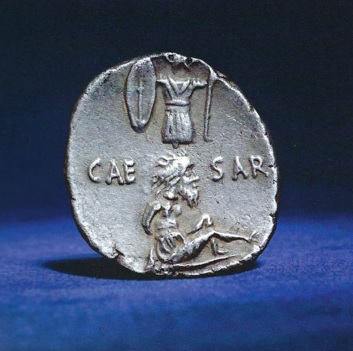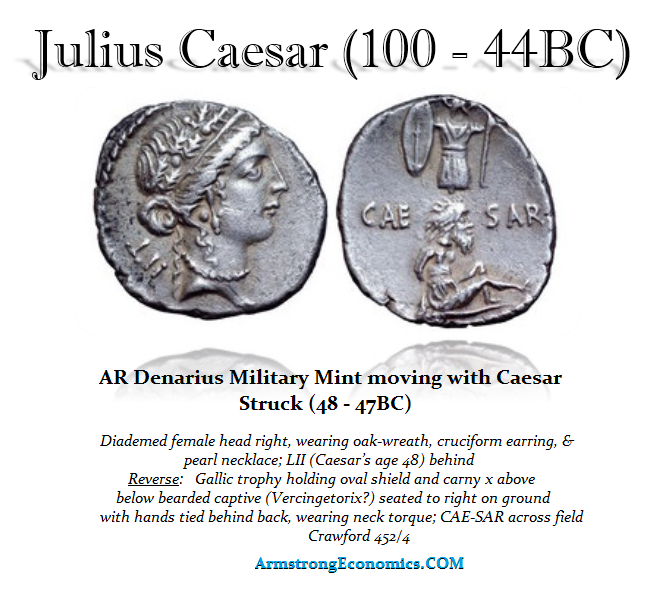With the help of his political allies, Caesar had succeeded in making himself the governor of Cisalpine Gaul and Illyricum, with Transalpine Gaul later added, giving him command of four legions. The term of this governorship, and therefore his immunity from prosecution, was set at an extraordinary five years, instead of the usual one. Deeply in debt, Caesar wasted little time in taking advantage of the unstable situation in Gaul to expand his territory through conquest, and thicken his holdings with plunder.
 What eventually became known as Caesar’s Gallic campaign was initially a piecemeal affair, but within six years he had expanded Roman rule over the whole of Gaul. Following years of relative success, mainly thanks to the disconnected nature of the tribes allowing him to take them on separately, he was faced with the chief of the Arverni tribe, Vercingetorix, who too late had built a confederation to stand against Caesar. In 52 BC, despite formidable resistance, Caesar finally defeated Vercingetorix at the Battle (or Siege) of Alesia. This illegal war which by Caesar’s own account had left a million dead, was instrumental in elevating him to a position of supreme power among the statesmen of the late Republic, making him incredibly wealthy through war booty, and also making him dangerously popular with the plebs.
What eventually became known as Caesar’s Gallic campaign was initially a piecemeal affair, but within six years he had expanded Roman rule over the whole of Gaul. Following years of relative success, mainly thanks to the disconnected nature of the tribes allowing him to take them on separately, he was faced with the chief of the Arverni tribe, Vercingetorix, who too late had built a confederation to stand against Caesar. In 52 BC, despite formidable resistance, Caesar finally defeated Vercingetorix at the Battle (or Siege) of Alesia. This illegal war which by Caesar’s own account had left a million dead, was instrumental in elevating him to a position of supreme power among the statesmen of the late Republic, making him incredibly wealthy through war booty, and also making him dangerously popular with the plebs.
Struck in the course of Caesar’s war against the Senatorial faction led by Pompey and later Metellus Scipio, Caesar’s triumphant coinage trumpets his military achievements and conquest in Gaul, while reminding the bearer also of his claimed descent from Venus through Aeneas. The reverse figure tied below the trophy of arms is popularly believed to depict the defeated Vercingetorix. Although Crawford and Sear are skeptical of this identification, it has often been said that the carefully rendered details of the figure, from the prominent brow and sunken eyes to the torque around his neck are highly suggestive of an individualized portrait. In 48/7 BC the defeated Gallic chieftain still languished in the Tullianum, the underground prison beneath the Comitium. He would be hauled out for Caesar’s triumph in 46, then returned to his cell and strangled.
This type is an early example of what would become a standard representation on the Roman imperial coinage of a defeated captive seated on the ground beneath or beside a trophy of arms, a type proclaiming conquest that was used to great effect by Vespasian and Titus following their victorious campaign in Judaea.
In order to consolidate his power when he returned, Caesar produced triumphant coinage to spread the news of his military capability. The reverse of this coin is popularly believed to depict Vercingetorix himself. Although Crawford and Sear are skeptical of this identification, it has often been said that the carefully rendered details of the figure, from the prominent brow and sunken eyes to the torque around his neck are highly suggestive of an individualized portrait. This is an early example of what would become a tradition on the coinage of portraying a defeated captive sitting on the ground, submissive to the might of the Romans.
This example of Julius Caesar AR Denarius was struck by a Military mint moving with Caesar to pay the troops on a regular basis between 48-47 BC. Caesar felt that Alexander the Great had conquered the world at a very young age. He felt his accomplishments were long in coming. That is most likely on the obverse we see “IIL” behind the head marking his age at the time – 48 years old.





